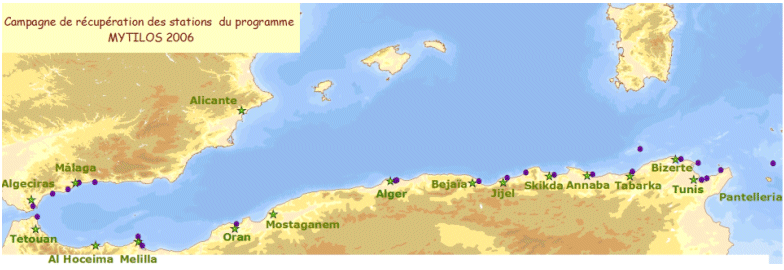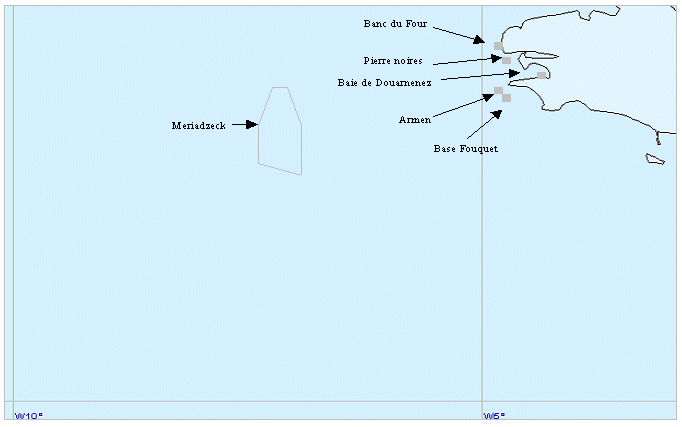Category
Campañas extranjeras
130 record(s)
Type of resources
Categories
Topics
INSPIRE themes
Keywords
Contact for the resource
Provided by
Years
Formats
Status
-

<p>The multi-annual partnership-based research programme SPIRAL (deep seismic and regional investigation in northern Algeria) aims to study the deep structure of the North Algerian margin using "high penetration" seismic methods: low frequency vertical reflection shooting, as well as wide angle reflection and refraction with deployment of listening stations on the seabed and onshore. The first strand of the SPIRAL programme SPIRAL involves the sea cruise to acquire geophysical data. This cruise took place aboard RV L'Atalante in two legs, respectively from 26/09 (Oran) to 10/10 2009 (Annaba) and from 13/10 (Annaba) to 10/11 2009 (Oran). These two legs provided acquisition of wide-angle seismic and penetrating multichannel seismic reflection data, which was the main objective of the project, as well as additional data like very high resolution (Chirp or sediment sounder type), magnetic and gravimetric, and multibeam bathymetric echosounder data. The profiles acquired during SPIRAL should supply elements to characterize the structural levels in and under the sediment cover (crust) down to the mantle in the targeted zones given in the cruise report; obtain accurate images of faulted and folded area and the major boundaries like the Moho; constrain the physical and rheological properties (particularly velocity models) which should help determine things like the nature of the crust at the continent-ocean transition. These constraints will make it possible to perform thermo-mechanical modelling on the scale of the Maghrebide belts to the base of the crust (temperature, density) and thus specify the main boundaries of the large crustal domains.</p>
-
Studying the role played by formation of deep water in the chemical composition and budgets of matter in the Mediterranean. Understanding the relationships between the way plankton food webs are organized and the hydrodynamic structures. The related project is MISTRALS - MerMEX.
-
<p>MOOSE-GE aims at 1) ensuring the maintenance of offshore French Mediterranean moorings and 2) carrying out an annual mapping of hydrological, biogeochemical and biological characteristics of the whole north-western basin. The related project are MERMEX, HYMEX, MISTRALS and MOOSE.</p>
-
Campaign GENESIS 2 "Pen Duick/Melilla", the second of three ROV campaigns, will focus on "Pen Duick Escarpment" in the Gulf of Cadiz or on the recently discovered "Melilla mounds" in the South-East Alboran Sea (Mediterranean Sea). The final choice of the study area will depend on the results of the TTR17 cruise with R/V Logachev (June-July 2008) and the R/V Marion Dufresne cruise (June 2008). One of these study areas will be surveyed using multibeam, side-scan sonar and high resolution seismics. Based on this site survey, the ROV Genesis will be deployed to carry out detailed mapping. Also the hydrography and sediment dynamics of the area will be studied with respect to the steering of the present ecosystems. GENESIS 2 takes place in the framework of the European projects HERMES (EC FP6), MiCROSYSTEMS (ESF) and HERMIONE (EC FP7).
-

Assessment of chemical contamination in coastal water masses (Spain, Morocco, Tunisia, Sicily canal), using artificial stations of mussels. The MYTILOS1 cruise aimed to utilize the RINBIO network methodology around the western Mediterranean, in the northern part of the NW Basin. Experiments run in the French Mediterranean since 1996 by IFREMER were to be extended to Southern Mediterranean coasts, i.e. Spanish, Moroccan, Algerian and Tunisian coasts, as well as the Sicily Canal in Italy, on the basis of a standardized protocol. The data from MYTILOS2 cruise will supplement those obtained in 2004 and 2005 during the RINBIOC1 and MYTILOS1 cruises by including the coasts of North Africa, Southern Spain and the island of Pantelleria. In addition, the results will be used to complement the chemical contamination budget drawn up in the framework of the European Water Framework Directive's implementation. The survey was based on 2 major actions: 1) Artificial mussel stations were placed and recovered along a shoreline between Malaga (Spain) and Sicily (Italy), including Morocco, Algeria and Tunisia. 2) Sediment samples in addition to mussels samples were taken upon the partners' request. This falls under the MEDICIS project.
-

Characterizing the variability of hydrological and current features and particulate fluxes on the continental rise of the Gulf of Lion and in the deep convection zone. Monitoring of deep benthic communities in the western canyons and on the continental rise of the Gulf of Lion.
-

Assessment of small pelagic species resources in the Gulf of Lion using echointegration and trawl hauls to identify the observed echoes. This fell under the SIDEPECHE project.
-
The objectives of the BELMER project are: - to validate the MERIS water products for Belgian coastal waters and neighbouring French, UK and Dutch waters - to provide a quantitative statement of product accuracy and recommendations for improvements in the scientific algorithms, where appropriate. In particular the problems reported by the MERIS validation and user communities of turbid water atmospheric correction, case 2 water chlorophyll retrieval, adjacency effects (straylight), moderate sunglint, spatio-temporal variability of specific inherent optical properties and bottom reflectance will be addressed. This project is funded by the "PROgramme for the Development of scientific Experiments" (PRODEX) of the European Space Agency (ESA).
-
SHOM cruise aboard the Pourquoi Pas?
-
The cruise D361 forms part of a study entitled 'Physical and chemical forcing of diazotrophy in the (sub)-tropical Atlantic Ocean'. The study is investigating the potential influence of iron and phosphorus availability on nitrogen fixation in regions of the tropical Atlantic Ocean. The cruise also undertakes deep trace metal clean CTD casts as part of the International GEOTRACES programme. The purpose of the cruise therefore is to undertake measurements of dissolved and particulate iron and phosporpus availability, their spatial and temporal variations, and their impact on diazotrophy in the surface ocean. Aim: To quantify the supply and determine the biogeochemical cycling of Fe and other nutrients, and relate this to N2 fixation, diazotroph species distribution and N* fields. 1. Quantify the distribution of nutrients and trace metals: Quantify surface water and water column distributions of dissolved inorganic/organic N, P, Fe, and DAl, DMn and particulate P, N, Fe, Al, Mn. 2. Quantify the rate of Fe, Al, Mn, P and N supply to surface waters: Assess the source fluxes of the key elements for diazotrophs and source tracers to the surface ocean from atmospheric deposition and internal transport via diapycnal mixing and lateral advection. 3. Identify the source of subsurface Fe enrichment: Identify whether Fe-rich subsurface waters of the tropical North Atlantic thermocline originate from the atmosphere or the shelf using Fe distributions and Al, Mn, and O2 source tracers. 4. Quantify the diazotrophic response to Fe, phosphate, DOP supply: Relate the spatial distributions of inorganic Fe and organically complexed Fe, and phosphate and DOP to diazotrophy. The specific uptake of Fe, phosphate and DOP by the whole microbial community and Trichodesmium will be assessed by shipboard incubations, radiotracer techniques and enzyme bioassays. In addition, we will identify the connection between N2 fixation rates and diazotroph community structure, by comparing size fractionated 15N2-derived rates of N2 fixation (Fig. 1) with abundance and diversity of diazotrophs using nifH phylogeny. Objective 5: Investigate how the large scale transport pathways of Fe and P influence the N* distribution: Use fine-scale isopycnic model to reveal the large-scale transport pathways of Fe and P in the (S)-T Atlantic, and their effect on the N* distribution.
 Catálogo de datos del IEO
Catálogo de datos del IEO